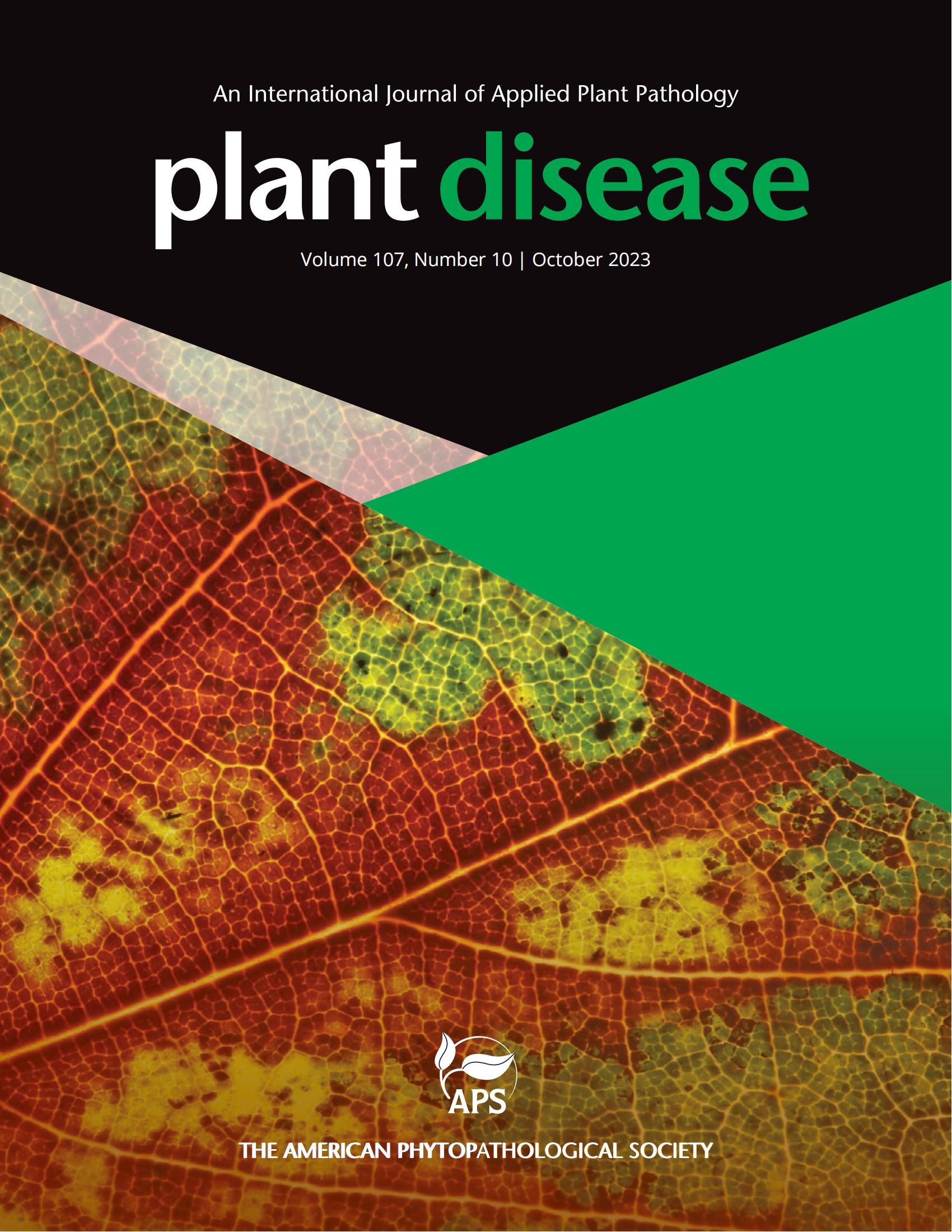一种由杏仁假单胞菌引起的杨梅细菌性胆管病。台湾的杨梅。
摘要
杨梅(Myrica rubra),或称山杨梅(yamamomo),是为生产果实和观赏目的而栽培的。2023年,台湾南投县仁爱国立中兴大学慧孙实验林报道了一种影响红毛杨的未知病害。该病表现为叶柄、嫩枝、小枝和树干上的虫瘿,特别是在小枝上。这些虫瘿看起来有裂缝,呈深褐色,不规则,表面粗糙。约80棵树的发病率为100%。2023年3月采集的样本显示血管内部变色,并观察到细菌流。将病变组织浸泡在无菌水中,将菌悬液涂布在营养琼脂上分离。纯化菌株对本烟叶片进行超敏反应(hypersensitive response, HR)实验,鉴定出6株菌株(MrBG-1 ~ MrBG-6)可引发HR反应。在22 ~ 25℃的日光环境下,对6株15月龄的黄松幼苗进行了下木本茎和上非木本茎的致病性测定。将6株菌株接种在3株幼苗上,其余3株幼苗用无菌水处理。每个菌株的悬浮液(20ul;108 CFU / mL)滴在接种部位针扎5 mm2的面积上。接种部位在接种后1个月出现裂缝,在接种后3个月木质组织上形成脓肿,非木质组织上形成溃烂,而对照组的伤口愈合。重新分离病原菌,通过16S rDNA测序(PV082408 ~ PV0824013)确认与原接种菌相同。由于分离株MrBG-1至MrBG-6在King's B培养基上产生荧光色素,因此进行了LOPAT测试(Schaad et al. 2001)。结果表明,该菌株产生levan,诱导烟草HR,缺乏氧化酶和精氨酸二水解酶活性,不引起马铃薯块茎片软腐病。这些特征与扁桃核的特征一致。杨梅(原杨梅)在日本引起红分枝杆菌胆症状的杨梅(myricae)菌株(Ogimi and Higuchi 1981)。利用最大似然法将DNA旋转酶B亚基(gyrB, PV089501 ~ PV089506)、RNA聚合酶β亚基(rpoB, PV089507 ~ PV089512)和RNA聚合酶sigma因子(rpoD, PV089513 ~ PV089518)的基因序列串联起来进行系统发育鉴定。用于扩增三个基因的引物和系统发育分析的参考菌株参考了先前的研究(Maleki-Zadeh et al. 2022)。系统发育结果显示,MrBG-1和MrBG-6属于杏仁假单胞菌的分支。自举值为86%的杨梅和通口。基于致病性试验、表型试验和系统发育分析,我们认为该疾病是由amygdali pv引起的。myricae。虽然台湾只在一个试验林中观察到该病,但在日本(冲绳)(Ogimi和Higuchi, 1981)和中国(Zhang和He, 1991)也有报道。由于该病菌影响杨梅的所有经济品种(Ogimi和Higuchi, 1981),因此对杨梅的利用构成重大威胁。Chinese bayberry (Myrica rubra), or yamamomo, is cultivated for fruit production and ornamental purposes. In 2023, an unknown disease affecting M. rubra was reported in the Huisun Experimental Forest, National Chung Hsing University, Renai, Nantou County, Taiwan. The disease is expressed as galls on petioles, young shoots, twigs, and trunks, particularly on twig branches. These galls appeared cracked, dark brown, irregular, and rough on surfaces. The disease incidence was 100% among approximately 80 trees. Samples collected in March 2023 exhibited internal vascular discoloration and bacterial streaming was observed. Diseased tissues were immersed in sterile water, and the bacterial suspensions were streaked on nutrient agar for isolation. Purified strains underwent hypersensitive response (HR) assays on Nicotiana benthamiana leaves, identifying six bacterial strains (MrBG-1 to MrBG-6) that triggered a HR reaction. Pathogenicity assays were performed on lower woody stems and upper non-woody stems of six 15-month-old M. rubra seedlings in a greenhouse (22 to 25℃) under natural daylight. The six bacterial strains were inoculated on three seedlings while the other three seedlings were treated with sterile water. A suspension of each strain (20 ul; 108 CFU / mL) was dropped on an inoculation site which was wounded with needles in an area of 5 mm2. Inoculation sites swelled with cracked surfaces at one month post-inoculation (mpi) and formed galls on woody tissue and cankers on non-woody tissue at three mpi, while wounds in the controls healed. The pathogens were re-isolated and confirmed identical to the original inoculated bacteria via 16S rDNA sequencing (PV082408 to PV0824013). Since isolates MrBG-1 to MrBG-6 produced fluorescent pigment on King's B medium, LOPAT tests were performed (Schaad et al. 2001). Results indicated that these isolates produced levan, induced HR in tobacco, lacked oxidase and arginine dihydrolase activity, and failed to cause soft rot in potato tuber slices. These characteristics were consistent with those of P. amygdali pv. myricae (formerly P. syringae pv. myricae) strains causing gall symptoms on M. rubra in Japan (Ogimi and Higuchi 1981). Phylogenetic identification utilized concatenated gene sequences of DNA gyrase subunit B (gyrB, PV089501 to PV089506), RNA polymerase beta subunit (rpoB, PV089507 to PV089512), and RNA polymerase sigma factor (rpoD, PV089513 to PV089518) by using the maximum likelihood method. The primers used for amplifying the three genes and the reference strains included in the phylogenetic analysis were referred from a previous study (Maleki-Zadeh et al. 2022). The phylogenetic results clustered MrBG-1 to MrBG-6 in the clade of Pseudomonas amygdali pv. myricae Ogimi and Higuchi with a 86% bootstrap value. Based on the pathogenicity assay, phenotypic tests, and phylogenetic analysis, we concluded that the disease is caused by P. amygdali pv. myricae. Although the disease in Taiwan has only been observed in an experimental forest, it has also been reported in Japan (Okinawa) (Ogimi and Higuchi, 1981) and China (Zhang and He, 1991). Since the pathogen affects all economic cultivars of Myrica rubra (Ogimi and Higuchi, 1981), it poses a significant threat to Chinese bayberry utilization.

 求助内容:
求助内容: 应助结果提醒方式:
应助结果提醒方式:


